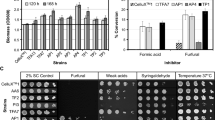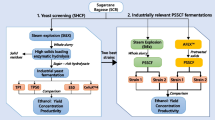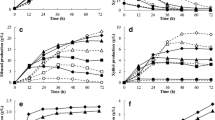Abstract
The fermentation of spent sulphite liquor (SSL) from the pulping of hardwoods is limited by the combination of xylose, the primary fermentable sugar and high concentrations of microbial inhibitors that decrease the yeast fermentation ability. The inhibitor resistance phenotypes of xylose-capable Saccharomyces cerevisiae strains were therefore enhanced by combining rational engineering for multi-inhibitor tolerance, with adaptation in concentrated hardwood SSL as selective pressure. The adapted strains were assessed in fermentations with 60–80% v/v concentrated SSL under industrially relevant fermentation conditions. During adaptation, strains produced ethanol concentrations between 11.0 and 15.4 g/L in the range of that reported in literature. The adapted TFA40 and TP50 strains displayed enhanced inhibitor resistance phenotypes and were able to ferment xylose-rich SSL at pH below 5, exhibiting improved ethanol yields relative to the reference strain. Using yeast extract and peptone as nitrogen source in concentrated SSL fermentations further improved ethanol yields. However, strains exhibited a trade-off between resistance and ethanol productivity, indicating a carbon/energy cost for the expression of this inhibitor tolerance phenotype.
Key points
• Achieved fermentation of xylose-rich hardwood spent sulphite liquor at pH below 5.0
• Adaptation of xylose-capable S. cerevisiae in concentrated spent sulphite liquor
• Adapted strains exhibited enhanced inhibitor resistance phenotypes.




Similar content being viewed by others
Availability of data and material
N/A
Code availability
N/A
References
Abdulkhani A, Amiri E, Sharifzadeh A, Hedjazi S, Alizadeh P (2019) Concurrent production of sodium lignosulfonate and ethanol from bagasse spent liquor. J Environ Manag 231:819–824. https://doi.org/10.1016/j.jenvman.2018.10.032
Almario MP, Reyes LH, Kao KC (2013) Evolutionary engineering of Saccharomyces cerevisiae for enhanced tolerance to hydrolysates of lignocellulosic biomass. Biotechnol Bioeng 110:2616–2623. https://doi.org/10.1002/bit.24938
Amato M, Ballco P, López-Galán B, De Magistris T, Verneau F (2017) Exploring consumers’ perception and willingness to pay for “non-added sulphite” wines through experimental auctions: a case study in Italy and Spain. Wine Econ Policy 6:146–154. https://doi.org/10.1016/j.wep.2017.10.002
Asadollahzadeh MT, Ghasemian A, Saraeian AR, Resalati H, Lennartsson PR, Taherzadeh MJ (2017) Ethanol and biomass production from spent sulfite liquor by filamentous fungi. Int J Biol Biomol Agric Food Biotechnol Eng 11:653–659
Bhatia SK, Jagtap SS, Bedekar AA, Bhatia RK, Patel AK, Pant D, Rajesh Banu J, Rao C, Kim YG, Yang YH (2020) Recent developments in pretreatment technologies on lignocellulosic biomass: effect of key parameters, technological improvements, and challenges. Bioresour Technol 300:122724. https://doi.org/10.1016/j.biortech.2019.122724
Branco RHR, Serafim LS, Xavier AMRB (2019) Second generation bioethanol production: on the use of pulp and paper industry wastes as feedstock. Fermentation 5:4. https://doi.org/10.3390/fermentation5010004
Brandt BA, García-Aparicio MDP, Görgens JF, van Zyl WH (2021) Rational engineering of Saccharomyces cerevisiae towards improved tolerance to multiple inhibitors in lignocellulose fermentations. Biotechnol Biofuels 14:173. https://doi.org/10.1186/s13068-021-02021-w
Cadière A, Ortiz-Julien A, Camarasa C, Dequin S (2011) Evolutionary engineered Saccharomyces cerevisiae wine yeast strains with increased in vivo flux through the pentose phosphate pathway. Metab Eng 13:263–271. https://doi.org/10.1016/j.ymben.2011.01.008
Caspeta L, Castillo T, Nielsen J (2015) Modifying yeast tolerance to inhibitory conditions of ethanol production processes. Front Bioeng Biotechnol 3:184. https://doi.org/10.3389/fbioe.2015.00184
Cunha JT, Romaní A, Costa CE, Sá-Correia I, Domingues L (2019a) Molecular and physiological basis of Saccharomyces cerevisiae tolerance to adverse lignocellulose-based process conditions. Appl Microbiol Biotechnol 103:159–175. https://doi.org/10.1007/s00253-018-9478-3
Cunha JT, Soares PO, Romaní A, Thevelein JM, Domingues L (2019b) Xylose fermentation efficiency of industrial Saccharomyces cerevisiae yeast with separate or combined xylose reductase/xylitol dehydrogenase and xylose isomerase pathways. Biotechnol Biofuels 12:20. https://doi.org/10.1186/s13068-019-1360-8
Deparis Q, Claes A, Foulquié-Moreno MR, Thevelein JM (2017) Engineering tolerance to industrially relevant stress factors in yeast cell factories. FEMS Yeast Res 17:fox036. https://doi.org/10.1093/femsyr/fox036
Ding M-Z, Wang X, Yang Y, Yuan Y-J (2011) Metabolomic study of interactive effects of phenol, furfural, and acetic acid on Saccharomyces cerevisiae. Omi A J Integr Biol 15:647–653. https://doi.org/10.1089/omi.2011.0003
Gorsich SW, Dien BS, Nichols NN, Slininger PJ, Liu ZL, Skory CD (2006) Tolerance to furfural-induced stress is associated with pentose phosphate pathway genes ZWF1, GND1, RPE1, and TKL1 in Saccharomyces cerevisiae. Appl Microbiol Biotechnol 71:339–349. https://doi.org/10.1007/s00253-005-0142-3
Harner NK, Bajwa PK, Habash MB, Trevors JT, Austin GD, Lee H (2014) Mutants of the pentose-fermenting yeast Pachysolen tannophilus tolerant to hardwood spent sulfite liquor and acetic acid, Antonie van Leeuwenhoek. Int J Gen Mol Microbiol 105:29–43. https://doi.org/10.1007/s10482-013-0050-y
Hasunuma T, Ishii J, Kondo A (2015) Rational design and evolutional fine tuning of Saccharomyces cerevisiae for biomass breakdown. Curr Opin Chem Biol 29:1–9. https://doi.org/10.1016/j.cbpa.2015.06.004
He Q, Chen H (2020) Increased efficiency of butanol production from spent sulfite liquor by removal of fermentation inhibitors. J Clean Prod 263:121356. https://doi.org/10.1016/j.jclepro.2020.121356
Helle SS, Murray A, Lam J, Cameron DR, Duff SJB (2004) Xylose fermentation by genetically modified Saccharomyces cerevisiae 259ST in spent sulfite liquor. Bioresour Technol 92:163–171. https://doi.org/10.1016/j.biortech.2003.08.011
Helle SS, Lin T, Duff SJB (2008) Optimization of spent sulfite liquor fermentation. Enzym Microb Technol 42:259–264. https://doi.org/10.1016/j.enzmictec.2007.10.004
Hou J, Qiu C, Shen Y, Li H, Bao X (2017) Engineering of Saccharomyces cerevisiae for the efficient co-utilization of glucose and xylose. FEMS Yeast Res 17:fox034. https://doi.org/10.1093/femsyr/fox034
Humpert D, Ebrahimi M, Stroh A, Czermak P (2019) Recovery of lignosulfonates from spent sulfite liquor using ceramic hollow-fiber membranes. Membranes (Basel) 9:45. https://doi.org/10.3390/membranes9040045
Jansen MLA, Bracher JM, Papapetridis I, Verhoeven MD, de Bruijn H, de Waal PP, van Maris AJA, Klaassen P, Pronk JT (2017) Saccharomyces cerevisiae strains for second-generation ethanol production: from academic exploration to industrial implementation. FEMS Yeast Res 17:fox044. https://doi.org/10.1093/femsyr/fox044
Kim D (2018) Physico-chemical conversion of lignocellulose: inhibitor effects and detoxification strategies: a mini review. Molecules 23:309. https://doi.org/10.3390/molecules23020309
Koppram R, Albers E, Olsson L (2012) Evolutionary engineering strategies to enhance tolerance of xylose utilizing recombinant yeast to inhibitors derived from spruce biomass. Biotechnol Biofuels 5:32. https://doi.org/10.1186/1754-6834-5-32
Lang GI, Rice DP, Hickman MJ, Sodergren E, Weinstock GM, Botstein D, Desai MM (2013) Pervasive genetic hitchhiking and clonal interference in forty evolving yeast populations. Nature 500:571–574. https://doi.org/10.1038/nature12344
Liu ZL (2011) Molecular mechanisms of yeast tolerance and in situ detoxification of lignocellulose hydrolysates. Appl Microbiol Biotechnol 90:809–825. https://doi.org/10.1007/s00253-011-3167-9
Mans R, Daran JMG, Pronk JT (2018) Under pressure: evolutionary engineering of yeast strains for improved performance in fuels and chemicals production. Curr Opin Biotechnol 50:47–56. https://doi.org/10.1016/j.copbio.2017.10.011
Martín C, Marcet M, Almazán O, Jönsson LJ (2007) Adaptation of a recombinant xylose-utilizing Saccharomyces cerevisiae strain to a sugarcane bagasse hydrolysate with high content of fermentation inhibitors. Bioresour Technol 98:1767–1773. https://doi.org/10.1016/j.biortech.2006.07.021
Narayanan V, Sànchez i Nogué V, van Niel EWJ, Gorwa-Grauslund MF (2016) Adaptation to low pH and lignocellulosic inhibitors resulting in ethanolic fermentation and growth of Saccharomyces cerevisiae. AMB Express 6:59. https://doi.org/10.1186/s13568-016-0234-8
Novy V, Krahulec S, Longus K, Klimacek M, Nidetzky B (2013) Co-fermentation of hexose and pentose sugars in a spent sulfite liquor matrix with genetically modified Saccharomyces cerevisiae. Bioresour Technol 130:439–448. https://doi.org/10.1016/j.biortech.2012.11.115
Patnaik R (2008) Engineering complex phenotypes in industrial strains. Biotechnol Prog 24:38–47. https://doi.org/10.1021/bp0701214
Pereira SR, Portugal-Nunes DJ, Evtuguin DV, Serafim LS, Xavier AMRB (2013) Advances in ethanol production from hardwood spent sulphite liquors. Process Biochem 48:272–282. https://doi.org/10.1016/j.procbio.2012.12.004
Pereira SR, Sànchez I, Nogué V, Frazão CJR, Serafim LS, Gorwa-Grauslund MF, Xavier AMRB (2015) Adaptation of Scheffersomyces stipitis to hardwood spent sulfite liquor by evolutionary engineering. Biotechnol Biofuels 8:50. https://doi.org/10.1186/s13068-015-0234-y
Petersen AM, Haigh K, Görgens JF (2014) Techno-economics of integrating bioethanol production from spent sulfite liquor for reduction of greenhouse gas emissions from sulfite pulping mills. Biotechnol Biofuels 7:169. https://doi.org/10.1186/s13068-014-0169-8
Rueda C, Marinova M, Paris J, Ruiz G, Coz A (2016) Technoeconomic assessment of different biorefinery approaches for a spent sulfite liquor. J Chem Technol Biotechnol 91:2646–2653. https://doi.org/10.1002/jctb.4868
Sakihama Y, Hasunuma T, Kondo A (2015) Improved ethanol production from xylose in the presence of acetic acid by the overexpression of the HAA1 gene in Saccharomyces cerevisiae. J Biosci Bioeng 119:297–302. https://doi.org/10.1016/j.jbiosc.2014.09.004
Sànchez Nogué V, Bettiga M, Gorwa-Grauslund MF (2012) Isolation and characterization of a resident tolerant Saccharomyces cerevisiae strain from a spent sulfite liquor fermentation plant. AMB Express 2:68. https://doi.org/10.1186/2191-0855-2-68
Sawai J, Yoshikawa T (2004) Quantitative evaluation of antifungal activity of metallic oxide powders (MgO, CaO and ZnO) by an indirect conductimetric assay. J Appl Microbiol 96:803–809
Sinner P, Stiegler M, Herwig C, Kager J (2021) Noninvasive online monitoring of Corynebacterium glutamicum fed-batch bioprocesses subject to spent sulfite liquor raw material uncertainty. Bioresour Technol 321:124395. https://doi.org/10.1016/j.biortech.2020.124395
Vees CA, Veiter L, Sax F, Herwig C, Pflügl S (2020) A robust flow cytometry-based biomass monitoring tool enables rapid at-line characterization of S. cerevisiae physiology during continuous bioprocessing of spent sulfite liquor. Anal Bioanal Chem 412:2137–2149. https://doi.org/10.1007/s00216-020-02423-z
Verduyn C, Postma E, Scheffers WA, Van Dijken JP (1992) Effect of benzoic acid on metabolic fluxes in yeasts: a continuous-culture study on the regulation of respiration and alcoholic fermentation. Yeast 8:501–517. https://doi.org/10.1002/yea.320080703
Villain-Gambier M, Courbalay M, Klem A, Dumarcay S, Trebouet D (2020) Recovery of lignin and lignans enriched fractions from thermomechanical pulp mill process water through membrane separation technology: pilot-plant study and techno-economic assessment. J Clean Prod 249:119345. https://doi.org/10.1016/j.jclepro.2019.119345
Wahlbom CFF, Van Zyl WH, Jönsson LJ, Hahn-Hägerdal B, Otero RRC, Cordero Otero RR (2003) Generation of the improved recombinant xylose-utilizing Saccharomyces cerevisiae TMB 3400 by random mutagenesis and physiological comparison with Pichia stipitis CBS 6054. FEMS Yeast Res 3:319–326. https://doi.org/10.1016/S1567-1356(02)00206-4
Winkler JD, Kao KC (2014) Recent advances in the evolutionary engineering of industrial biocatalysts. Genomics 104:406–411. https://doi.org/10.1016/j.ygeno.2014.09.006
Xie CY, Yang BX, Wu YJ, Xia ZY, Gou M, Sun ZY, Tang YQ (2020) Construction of industrial xylose-fermenting Saccharomyces cerevisiae strains through combined approaches. Process Biochem 96:80–89. https://doi.org/10.1016/j.procbio.2020.05.022
Xing Y, Cheng Z, Shan S (2019) Dynamic soft sensing of organic pollutants in effluent from UMIC anaerobic reactor for industrial papermaking wastewater. IOP Conf Ser: Mater Sci Eng 490:62027. https://doi.org/10.1088/1757-899X/490/6/062027
Funding
This work was supported by the National Research Foundation (NRF) for financial support to the Chair of Energy Research: Biofuels and other clean alternative fuels (NRF Grant 86423).
Author information
Authors and Affiliations
Contributions
BAB: conceptualisation; methodology — design of experiments; investigation, formal analysis, data curation; writing — original draft. MDPGA: methodology — design of experiments, data curation, writing — review and editing. JFG: supervision; writing — review and editing. WHVZ: supervision; writing — review and editing. All authors read and approved the manuscript.
Corresponding author
Ethics declarations
Ethics approval
This article does not contain any studies with human participants or animals performed by any of the authors.
Competing interests
The authors declare no competing interests.
Additional information
Publisher’s note
Springer Nature remains neutral with regard to jurisdictional claims in published maps and institutional affiliations.
Supplementary Information
ESM 1
(PDF 261 kb)
Rights and permissions
About this article
Cite this article
Brandt, B.A., García-Aparicio, M.P., Görgens, J.F. et al. Adaptation of Saccharomyces cerevisiae in a concentrated spent sulphite liquor waste stream for increased inhibitor resistance. Appl Microbiol Biotechnol 106, 455–468 (2022). https://doi.org/10.1007/s00253-021-11710-3
Received:
Revised:
Accepted:
Published:
Issue Date:
DOI: https://doi.org/10.1007/s00253-021-11710-3




